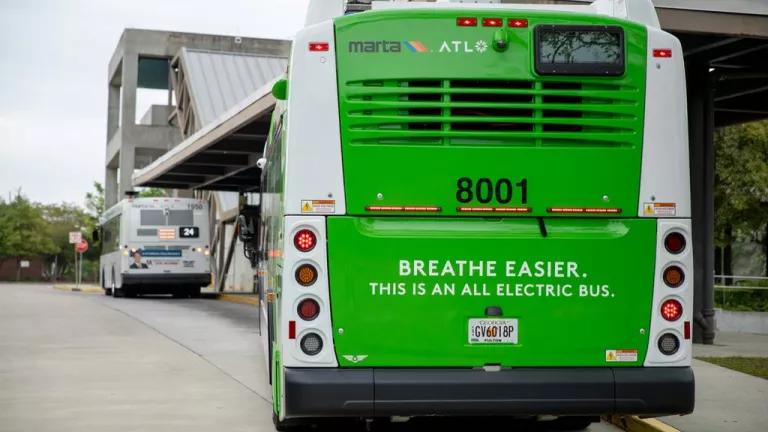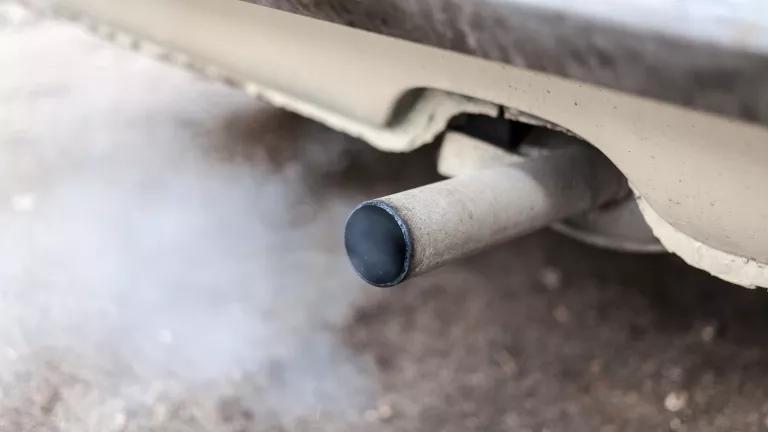Driving Clean Transportation Forward in Virginia
NRDC's recently published scorecard shows some of the progress being made in the state, but also highlights the significant work that remains to be done.

NRDC's new national report, a snapshot of each state’s decisions on transportation-related policies and investments, ranks the Commonwealth 18th out of 50. The Scorecard ranks each U.S. state on a number of different metrics, including state planning, vehicle electrification, expanding mobility choices, among others aimed at identifying which states are advancing equity and climate outcomes in the transportation sector.
With a score of 38.8 out a total of 100 possible points, Virginia is ranked the highest out of any Southern state, thanks to policies to accelerate the transition to zero tailpipe-pollution vehicles and support smart, equitable growth. These key policy advances include: the Advanced Clean Cars Standards, which decreases gas-powered vehicle pollution and also ensures the availability of zero emission electric vehicles, as well as a provision in the state code that mandates cities and counties promote transit-oriented development in their comprehensive plans.
These are important policies and a solid starting point for a state so uniquely threatened by looming climate change and its human and economic damage. Transportation is the largest source of greenhouse gas emissions in Virginia, where it makes up 42.1% of overall state emissions. Unlike many leading states, Virginia has not yet adopted a statewide climate strategy, nor has it formally adopted greenhouse gas reduction targets as part of its transportation planning, project selection, or funding decisions.
Adopting one soon is crucial to ensure the way Virginians move themselves and goods around tackles climate change, rather than make it even worse.

The Commonwealth Also Needs Safer Streets
Despite its 18th-place place in this year’s scorecard, Virginia has one of the lowest scores in the South relating to cyclist and pedestrian safety. The state received a total of 2.4 points out of a possible 6 points in the category of non-motorized serious injuries and fatalities on roadways in comparison to the state population. Like many states across the country, the Commonwealth is seeing a sharp rise in roadway injury and death due to changes in driver behaviors following the COVID-19 pandemic.
The number of pedestrian deaths has risen by 46% in the US over the past decade; worse, Black and Indigenous roadway users make up a disproportionate percentage of those fatalities. The Virginia Department of Transportation (VDOT) and municipalities in the Commonwealth must do better to ensure the safety of all roadway users by prioritizing safety over speed. The last 60 years of transportation infrastructure investments have created a system that seeks to move passenger vehicles as quickly possible, to the detriment of other modes of transport such as walking or biking.
To address this growing safety and environmental crisis, cities across the Commonwealth should adopt Vision Zero policies, aimed at reducing all roadway fatalities and serious accidents, by prioritizing the most vulnerable roadway users. In addition to developing an overall vision to achieve the goal of zero roadway deaths, cities should greenlight projects that provide physical protection for people walking and biking, like protected bike lanes and concrete jersey barriers. Cities should redesign roads and reduce speed limits, especially along routes that are intended for walking and biking. These measures and others like it can be funded at no additional costs to taxpayers: all that is required is a reallocation of funds away from unnecessary and wasteful highway projects to bicycle and pedestrian projects.
Virginians Need More Mobility Options
Virginia received a total of 13.5 points out of a possible 34 points in regards to expanding transportation options. Like most state departments of transportation, the overwhelming majority (42%) of VDOT’s budget for fiscal year 2024 is dedicated solely to highway construction.
A budget is of course not just a collection of numbers, but an expression of our values and aspirations. If this is true, based on VDOTs historic and current spending priorities, then an ever-expanding highway system is the Commonwealth’s aspiration, and our policymakers and lawmakers value the automobile over any other mode of travel. Prioritizing individual, single-occupant vehicles leads to an ever-expanding interstate system that demands a constantly growing budget just to maintain itself. Worse, expanding interstates leads to induced demand, which perpetuates further the cycle of ever-expanding interstates and congestion.

Induced demand is simple and well-demonstrated: if you make something that seems easier for people to do—in this case, a perceived faster travel time due to more highways lanes—people will do more of it. Over time, more people shift their travel patterns instead of replacing a trip with public transit or waiting until after peak traffic. Induced demand ultimately creates a cycle of ever-expanding interstates and congestion. Recent survey data shows that voters are well aware of this phenomenon, with the majority agreeing that "widening highways attracts more people to drive, which creates more traffic in the long run."
Virginia’s lawmakers and policymakers should heed well-demonstrated wisdom and stop trying to pave our way out of endless gridlock, and make smarter, cleaner, more fiscally-sustainable investment instead.
Establish Clear and Measurable Transportation Goals
It may come as no surprise to Virginians that the state has not yet adopted a statewide climate strategy, given Govenor Glenn Youngkin’s crusade against sensible emissions regulation. Nor has the state established a quantified goal for reducing vehicle miles traveled per licensed driver, unlike many others (including North Carolina, also in the South). Without a clear target or existing priorities, the state has no benchmark from which to measure success or a clear direction for its public agencies to focus their efforts.
While Virginia has made significant progress, much work remains, but at least the solutions are clear: we should seize them today.
Want to take action on clean transportation? Urge your governor to embrace and enact our recommendations through their Department of Transportation!




